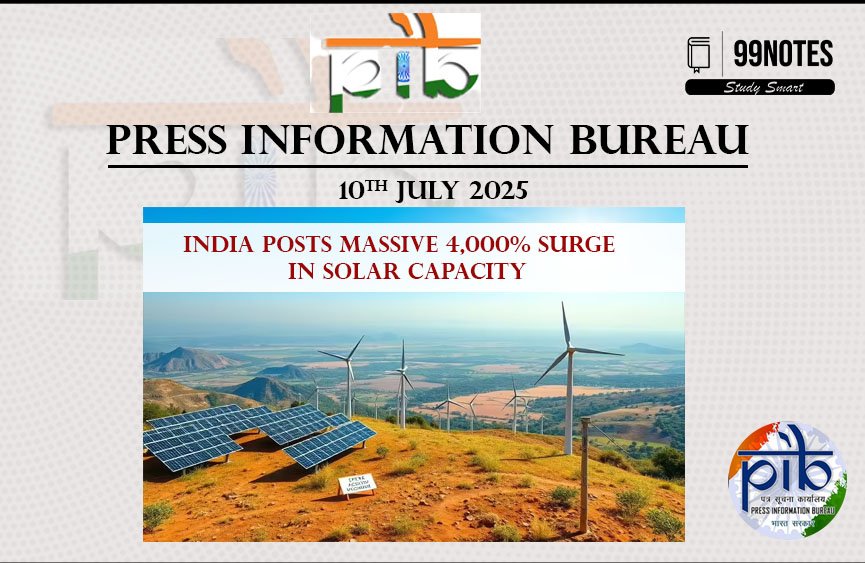11 July 2025: PIB Summary For UPSC
1. India Posts Massive 4,000% Surge in Solar Capacity
(Source – PIB (Press Information Bureau), July, 11, 2025)
|
Topic: GS Paper 3 — Renewable Energy & Infrastructure; Climate Change and Related Policy; Energy Security |
|
Context |
|
Content
Overview
-
4,000% growth in installed solar capacity, contributing to total renewable energy capacity of 227 GW.
-
India is likely the first G20 nation to fulfil its Nationally Determined Contributions (NDCs) under the Paris Agreement.
Significant Milestones & Initiatives
-
India’s photovoltaic (PV) module production has increased 38‑fold in the last decade; PV cell production has seen a 21‑fold rise.
-
The PM Surya Ghar Yojana targets rooftop solar installation in 1 crore (10 million) households, reducing bills and promoting self‑reliance.
-
Agriculture-focused programmes like PM‑KUSUM further disseminate solar adoption among farmers.
Four‑Pronged Strategy for Energy Independence
-
Targeted Innovation: Focus on next‑gen battery chemistries (solid‑state, hybrid), circular supply chains, and deep R&D.
-
Infrastructure Development: Expand EV charging, battery swapping networks, and energy storage systems.
-
Supply Chain Resilience: Diversify raw‑material, component and manufacturing bases to avoid dependence.
-
Full Value‑Chain Ecosystem: Build a domestic ecosystem including raw materials, ACC cells, battery packs, recycling, and supporting services.
₹1 Lakh Crore Innovation Fund
-
Union Cabinet has approved a ₹1 lakh crore (INR 100,000 crore) Research, Development & Innovation Fund to boost next‑generation battery technologies, aiming to compete with R&D levels in advanced economies (₹6–7 lakh crore), while leveraging India’s cost advantage.
Model Case Study
-
Palli village in Jammu & Kashmir has become India’s first carbon‑neutral panchayat, using solar generation and energy‑efficient infrastructure.
-
IESW 2025 venue, Yashobhoomi, exemplifies sustainability with rooftop solar, wastewater treatment, and energy‑efficient design.
Analysis for UPSC Aspirants
-
Illustrates India’s shift from fossil fuels to renewables as part of energy transition, and implications for climate goals.
-
Demonstrates strategic uses of mission‑mode planning, PLI schemes, and financial instruments in scaling renewable capacity.
-
Highlights the importance of decentralised solar, green hydrogen, battery innovation, and South‑South cooperation in supply chain resilience.
-
The Innovation Fund underscores India’s intent to become a global innovation hub in clean energy technology.
Conclusion
India’s solar growth—4000% increase—and structural programmes like PM Surya Ghar and PM‑KUSUM reflect a scalable model for decarbonisation. The ₹1 lakh crore battery innovation fund is a key step toward indigenising high-tech clean energy supply chains. To sustain momentum, India must ensure:
-
Efficient implementation of R&D outcomes,
-
Strengthening manufacturing and recycling ecosystems,
-
Scaling decentralized adoption in rural/agricultural sectors, and
-
Enhancing global partnerships for raw-material security and technology transfer.
|
Practice Question: “Critically examine the role of mission-driven initiatives and innovation funding in India’s pursuit of energy self-reliance and climate targets. In what ways do such measures contribute to meeting Nationally Determined Contributions under the Paris Agreement? Illustrate with relevant examples.” |
Check this out 10 July 2025: PIB Summary For UPSC


